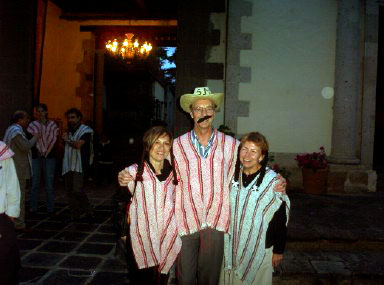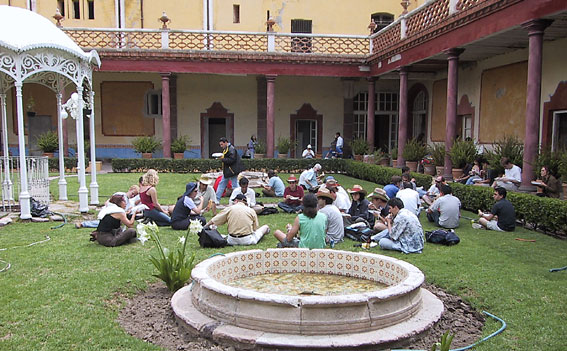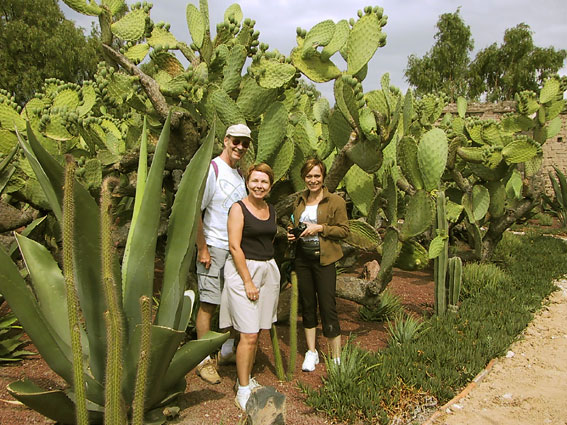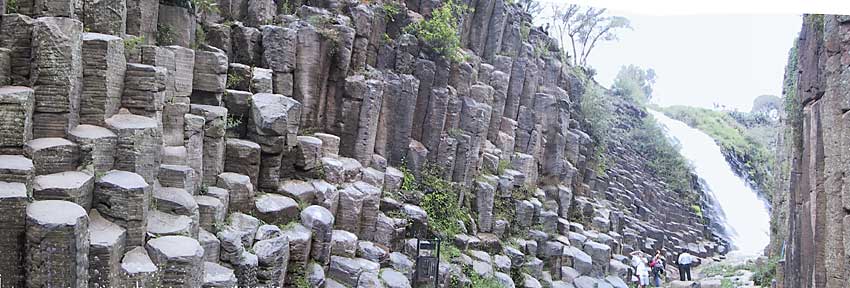MEMORIES
The second in the new series of Latin American Schools of High-Energy Physics took place in San Miguel Regla, Mexico, from 1 to 14 June. Organized jointly by CERN and CLAF (Centro Latino Americano de Fisica) together with the Division of Particles and Fields of the Mexican Physical Society, the School was attended by fifty students coming from eleven different countries. The School was hosted in the beautiful Hacienda San Miguel Regla, located about 100 kms north of Mexico City. San Miguel Regla is a charming and typical Mexican village with small shops, riders and horses, and where only the main street is covered by tar. The village, which is located in the valley of the "Huasca", is surrounded by a pleasant forest atmosphere.
The School participants were lodged in different renovated buildings spread over the domain of the Hacienda, which was built in the XVII century and belonged to "Pedro Romero de Terreros", "Conde de Regla". According to the tradition of the School the students were sharing twin rooms (most of them having a beautiful fire place), mixing nationalities and in particular European together with Latin American students . Doctor Alberto Sanchez-Hernandez from Cinvestav, Mexico was acting as local director for the School.
The food was typically Mexican with a lot of tacos, enchiladas, etc. However, in addition most of the days trout from a fish-breeding close to the Hacienda was served cooked in a variety of styles.
The lectures were held in the Hacienda’s conference room where the students also displayed their work in the form of posters on a special evening session the first week. The posters were pinned on the walls and were kept up until the last day when they were taken down to be replaced by decorations for the farewell banquet.
During their free time the students had the possibility of making nice walks, in particular in the forest surrounding the fish-breeding close to the Hacienda, and also of visiting the market and the shops of Huasca, a typical Mexican village roughly 6 kms away. Also the Hacienda’s swimming pools were frequently used even though occations of heavy rain could be equally refreshing.
At night the participants were happily gathering in the bar for exotic drinks, music and singing. However, it was somewhat disappointing that the bar was closing too early and was not even open every night.
Tour of the Hacienda.
On one of the first evenings the school participants were provided with torches and walking in formation along the main path, the history of the Hacienda was told by one of the hotel staff. The guided tour was followed by a splendid medieval dinner served in the “cave “of the Hacienda and accompanied by a great Mariachi band who kept on playing and singing throughout the meal.
After the meal there was an impressive firework by the swimmingpool ending with the name of “CERN” sparkling in the Mexican sky.
Sunday Morning
On Sunday morning the pool house was used to serve a special Mexican breakfast with specialities like meat folded in cactus leafs and cooked in the wooden ashes of a big fire.
One evening in the second week the participants were equipped with Mexican hats, and ponchos in addition to black wigs with braids for the females and moustaches for the males, and looking like authentic Mexicans we were again served a special dinner accompanied by another Mariachi band.

The CERN Team
Montezuma
Many of the participants had the “pleasure” of a special visit by Montezuma. Even though many suffered from his revenge, everybody continued to participate both in the lectures and the social activities. In gratitude the farewell party was therefore dedicated to Bactrim. On the positive side this incident allowed us to meet the very nice village doctor, who had been practicing in the US and spoke english well, and who paid us a visit every day. We also discovered that in Mexico current medecine is sold in groceries!
Excursions
On Saturday 7th there was a full-day excursion to Teotihuacán, “the City of the Gods”.
Few cities in the world have been considered worthy of being inhabited by Gods, who are accustomed to occupying loftier realms. Teotihuacán, which is such a city, arose as a new religious center in the Mexican Highland, around the time of Christ. Between 1 AD and 250 AD the ceremonial core was completed. The colossal pyramids were painted red to glow under the Mexican sun. The development of the city seems to have involved inter-site population movements, exploitation of natural resources, an increase in agricultural production, technological inventions, establishment of trading systems and other kinds of socio-political organizations and belief systems. By the fourth century, unmistakable influences of Teotihuacán were felt throughout most parts of Mesoamerica. Teotihuacán was the sixth largest city in the world during its period of greatest prosperity, according to an estimated population of 125,000.
The construction extended over 20 square kilometers. The Avenue of the Dead was the city's primary axis, extending more than 2 km, with the canalized river San Juan crossing at right angles. Part of it was lined with long talud-tablero platforms. The width of the avenue varies between different sections from 40 to 95 m. As originally built, the Sun Pyramid (the third largest pyramid in the world) was approximately 215 by 215 m at the base, and about 63 m high. It was enlarged at least twice in later periods, resulting in a final size of 225 m along each side. The pyramid is located on the east side of the Avenue of the Dead in the northern half of the city. The Moon Pyramid located at the northern end of the Avenue and facing south was built as the principal monument of the Moon Pyramid complex. The five-tiered platform was attached to the front of the Moon Pyramid.

The Sun and the Moon Pyramids
And these are the pyramids that the most courageous School participants climbed, some only one and some both.
A crowd of mechants at the site gave the students the best opportunities to test their bargaining skills.
More details at
http://archaeology.la.asu.edu/teo/
And at
http://www.mexicocity.com.mx/teoti_i.html
and
http://www.differentworld.com/mexico/places/mexico_city/teotihuacan.htm
On the way back from Teotihuacán and after intensive search an abandoned Hacienda was finally found in the middle of nowhere. This beautiful Hacienda in full renovation was our destination for a picnic which was taken in the Hacienda’s beautiful atrium.

Picnic
The picnic was followed by a visit to the garden with its huge cactuses. Apparently the juice from the cactus has been used to produce an aphrodisiastic drink, but unfortunately nothing was available for testing.

Cactuses
On the way back to San Miguel Regla we stopped in Real del Monte, a nice, little mining city with several bars, but better known for its red roofs. The students were in particular appreciating a famous local cake.
The excursion foreseen for the last Wednesday to Prisma Basalticas drowned in a spectacular rain storm.

Prisma Basalticas
Only Danielle and Egil started out courageously, but were quickly discouraged to return to the Hacienda - logically soaked wet. More intelligent students preferred stying inside playing “rotating” tennis table with unlimited number of simultaneous players, and where Henning gave a great performance playing with his bare hands.
On the last evening the traditional Farewell Banquet was celebrated in the conference room magnificently set up for this purpose. A very professional orchestra was playing from the large podium
Various delicious dishes were served accompanied by large quantities of good, red wine. Alberto Sanchez Director of the “Mexican School” and Egil Lillestol, Director of the CERN Schools gave very pleasant farewell talks. Anecdotes collected during the two weeks of the School were turned into reasons to congratulate some "deserving" students, and small presents were offered by CERN.
Some of the students had prepared sketches, and a show. Henning-Jurgen was acting as a “Monsieur Loyal” and presented an overview of the School. All the lecturers and discussion leaders were caricatured and received awards according to their “merits”.
Among the entertainment presented by highly “professional” students was a national dance performed by two female and two male students dressed in Mexican costumes, a very impressive performance.
Then it was time for everybody to take active part in games and dancing. A “musical chair” game turned into a hard fight with a merited victory of Alejandro Ayala.
In the traditional Piñata game, also known in Spain, a cowlike puppet stuffed with candies and hanging from a tree was “attacked” with a stick by players – one after the other, not too easy with covered eyes and with the puppet being moved around. Finally Johana Chirinos managed to break it and received a nice sombrero as the winner. The candies, having been spread all over the place, were now collected by the watching participants in a frantic race.
Alejandro also demonstrated great Salsa skills probably due to his excellent dancing partner Marta.
This was a GREAT School !